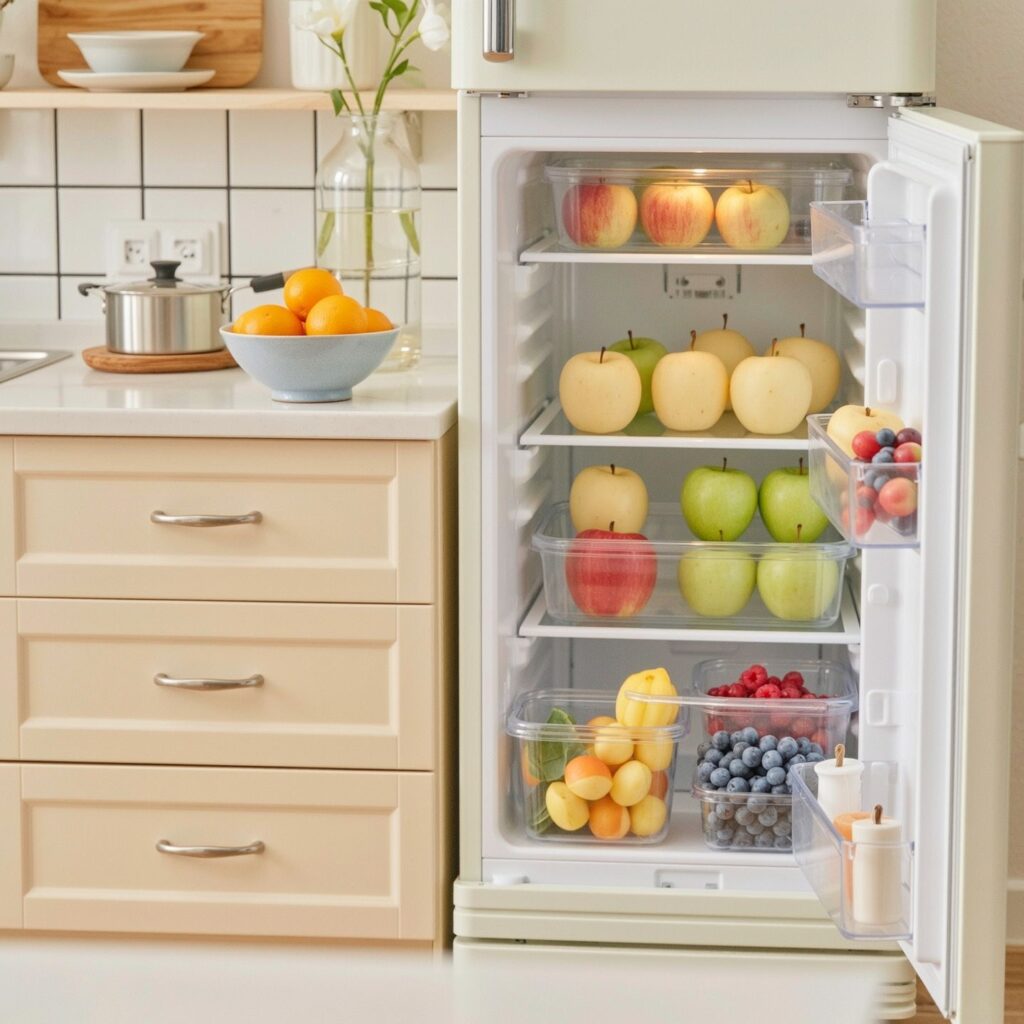
We’ve all been there—buying a container of fresh, beautiful raspberries only to find them covered in mold just two days later. It’s frustrating, feels wasteful, and leaves you rethinking your meal plans.
The good news? With the right fruit storage tips, you can keep your produce fresher for longer, saving money and reducing frustration.
Our comprehensive Store Fresh System breaks down exactly how to store fruits based on their unique needs—because every fruit has its own personality.
Table of Contents
- The Two Golden Rules of Fruit Storage
- The Delicate Task: How to Store Berries for Lasting Freshness
- The Hardy Heroes: How to Store Apples and Pears
- The Countertop Crew: Storing Bananas, Citrus, and Stone Fruit
- The Best Way to Store Grapes and Keep Them Plump
- Your Blueprint for a Fresher, Less Wasteful Kitchen
- Frequently Asked Questions
- References
The Two Golden Rules of Fruit Storage
Rule #1: Wash Only Before You Eat
Moisture is a leading cause of mold, especially for delicate fruits like berries. Wash fruits only right before eating them. Freshly washed fruit left in the fridge often traps water, creating an ideal environment for mold to grow.
- Pro Tip: If you’ve already washed berries, lay them out on a paper towel to dry thoroughly before storing.
Rule #2: Know Your Ethylene Producers
The Delicate Task: How to Store Berries for Lasting Freshness
How to Store Strawberries
- Wash: Use a vinegar-water solution (1 part vinegar to 3 parts water) before refrigerating to kill mold spores.
- Dry: Thoroughly pat the berries dry.
- Store: Lay them in a single layer on a paper towel inside a shallow, airtight container.
How to Keep Blueberries Fresh
- Do Not Wash: Keep them dry before refrigerating.
- Storage Tip: Store in their original, breathable container in the fridge.
- Shelf Life: They’ll last up to 10 days when refrigerated properly.
How to Store Raspberries
- Do Not Wash: Wait until just before eating.
- Keep Dry: Store raspberries in their original container, ensuring good air circulation.
- Shelf Life: Eat within 1–2 days for the best results.
The Hardy Heroes: How to Store Apples and Pears
How to Store Apples
- Separation is Key: Store apples in the fridge’s crisper drawer, away from other produce.
- Humidity Matters: Use a high humidity setting in the crisper to keep apples crispy and fresh.
Storing Pears for Perfect Ripeness
- Ripen on the Counter: Allow pears to ripen at room temperature.
- Refrigerate: Once ripe, move pears to the fridge to slow the ripening process.
The Countertop Crew: Storing Bananas, Citrus, and Stone Fruit
Your Banana Ripening Guide
- On the Counter: Keep bananas at room temperature, away from other produce to prevent ethylene exposure.
- Slowing Ripening: Separate bananas from the bunch, then wrap the stem in plastic wrap to slow ripening.
Citrus Fruit Storage
- On the Counter: Lemons, limes, and oranges can sit here for about 1 week.
- Slowing Ripening: For longer storage, move citrus to the fridge’s crisper drawer in a breathable bag.
Handling Peaches, Plums, and Avocados
- Ripen First: Keep stone fruits and avocados on the counter until they soften.
- In the Fridge: Once ripe, refrigerate to preserve their peak ripeness for a few extra days.
The Best Way to Store Grapes and Keep Them Plump
- Keep in Original Packaging: Grapes should be stored in their perforated plastic bag. This encourages air circulation and prevents moisture buildup.
- Do Not Wash: Wait to wash until just before eating.
- Shelf Life: Refrigerated grapes can stay fresh for 1–2 weeks.
Your Blueprint for a Fresher, Less Wasteful Kitchen
Frequently Asked Questions
What is the best way to store fresh fruit?
What is the best method to preserve fruits for long-term storage?
How long will fresh fruit last in the fridge?
Can I store my apples and oranges together on the counter?
I washed my strawberries as soon as I got home. Are they ruined?
What is the best way to store cut fruit, like melon or pineapple?
How can I quickly ripen a hard avocado?
Why do my bananas get brown spots in the fridge?
Should I store fruit in airtight containers or breathable ones?
What is the single biggest mistake people make with fruit storage?
The single biggest mistake people make when storing fruits is washing them before storage. This introduces moisture and accelerates spoilage.
